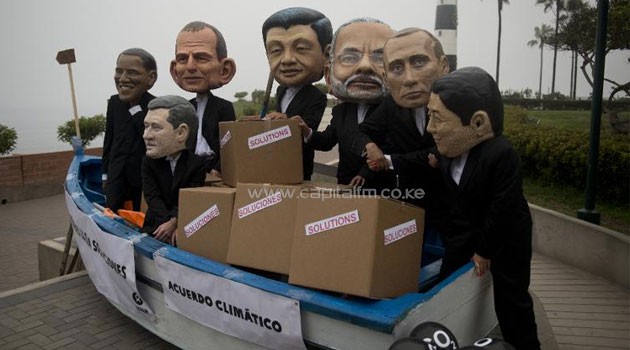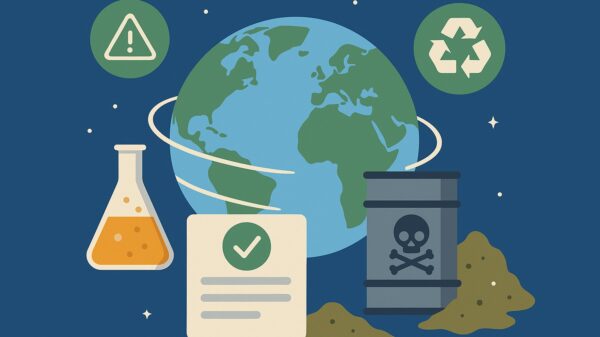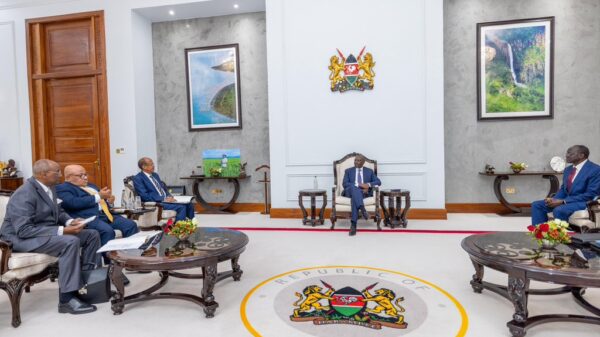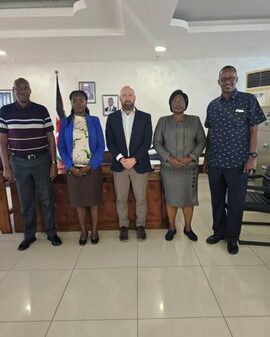
Activist depicting world leaders demonstrate on the sidelines of the UN COP20 and CMP10 climate change conferences being held in Lima on December 12, 2014
© AFP
GENEVA, Feb 13 – Negotiators in Geneva are geared to adopt a climate blueprint Friday, a symbolic milestone in the fraught UN process that must culminate in a universal pact in Paris in December.
Assembled over the past six days, the 86-page draft plan for limiting manmade global warming is due to be adopted at a closing session that starts at 1400 GMT.
“We have now agreed on a negotiating text,” Elina Bardram, head of the EU delegation, told AFP.
“It provides us with the basis for moving forward.”
Ever since the 2009 Copenhagen conference failed to deliver a world agreement, the 195 nations gathered under the UN Framework Convention for Climate Change (UNFCCC) have been working on a new project for adoption by the end of this year.
Set to be inked at the November 30-December 11 UNFCCC Conference of Parties (COP) in Paris, the pact must enter into force by 2020 to further the UN goal of limiting warming to two degrees Celsius (3.6 degrees Fahrenheit) over pre-Industrial Revolution levels.
Scientists warn that at current greenhouse gas emission trends, Earth is on track for double that, or more — a recipe for catastrophic droughts, storms, floods and rising seas.
Negotiators emerged from the last COP in Lima last December, with a hard-fought framework text that remained hotly contested.
The February 8-13 Geneva talks, one of three special sessions added to this year’s official UN climate agenda, was tasked with “streamlining” the Lima document.
Instead, the text more than doubled since Sunday until all countries were satisfied their views were included.
The process was widely hailed for creating a sense of common purpose and goodwill in a text with universal buy-in.
“But we would have wished for more advancement,” said Bardram.
“The introduction of missing elements in the text is an achievement, but it does mean that the tough negotiations lie ahead of us and we are running out of time.
“We need a step change between now and Paris.”
The draft lists a variety of alternative approaches on most issues — often reflecting country positions that diametrically oppose one another.
And that means hard choices will have to me made in the months to come — starting with the next negotiating round in Bonn in June.
– Options from A to Z –
“All the crunch issues are still on the table,” said Climate Action Network spokeswoman Alix Mazounie. “We have options going from A to Z”.
At the very core of the pact, countries remain deeply divided on the issue of “differentiation” — how to share responsibility for emissions cuts between rich and poor nations.
Developing countries also want their developed counterparts to commit to long-term climate financing — a thorny issue.
“There are tremendous issues that remain to be resolved,” veteran observer Alden Meyer of the Union of Concerned Scientists said.
“The first step before you can get to addressing those is to have a common picture of what the agreement is going to look like in terms of what the outline is, what the elements are in it. They have it now.”

































